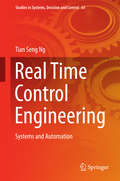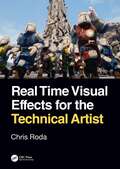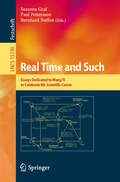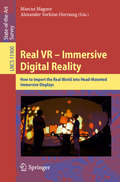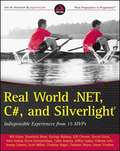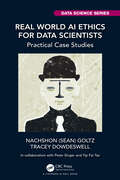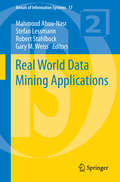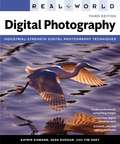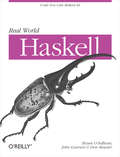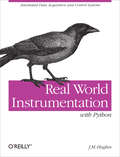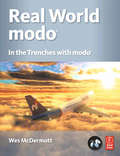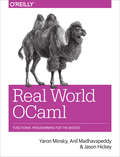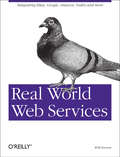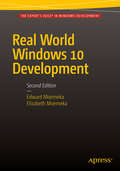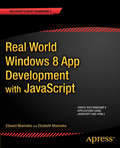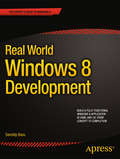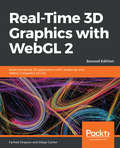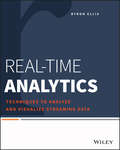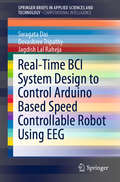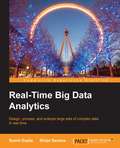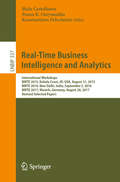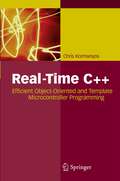- Table View
- List View
Real Time Control Engineering
by Tian Seng NgThis book covers the two broad areas of the electronics and electrical aspects of control applications, highlighting the many different types of control systems of relevance to real-life control system design. The control techniques presented are state-of-the-art. In the electronics section, readers will find essential information on microprocessor, microcontroller, mechatronics and electronics control. The low-level assembly programming language performs basic input/output control techniques as well as controlling the stepper motor and PWM dc motor. In the electrical section, the book addresses the complete elevator PLC system design, neural network plant control, load flow analysis, and process control, as well as machine vision topics. Illustrative diagrams, circuits and programming examples and algorithms help to explain the details of the system function design. Readers will find a wealth of computer control and industrial automation practices and applications for modern industries, as well as the educational sector.
Real Time Visual Effects for the Technical Artist
by Chris RodaVisual effects (VFX) are one of the most complicated components of feature film and television creation. With advancements in such technologies as Ray Tracing and Virtual Reality, the visual quality of the real-time rendering engine is now rivaling feature film. Real-time rendering requires years of programming experience with advanced understanding in math and physics. As the power of the real-time rendering engine improves, so too do the interfaces for VFX creation. With limited technical understanding, artists can create VFX with the push of a button and tug of a slider. As powerful as the interfaces are, they can only expose a portion of the true potential of the rendering engine. Artists are limited by their understanding of the engine interface. Real Time Visual Effects for the Technical Artist is written for digital artists to explain the core concepts of VFX, common in all engines, to free them from interface bounds. Features: Introduces the reader to the technical aspects of real-time VFX Built upon a career of more than 20 years in the feature film VFX and the real-time video game industries and tested on graduate and undergraduate students Explores all real-time VFX in four categories: in-camera effects, in-material effects, simulations, and particles This book is written to complement undergraduate- or graduate-level courses focused on the fundamentals of modern real-time VFX. Chris Roda is a Technical Art instructor at the Florida Interactive Entertainment Academy (FIEA), a graduate degree program in interactive, real-time application development at the University of Central Florida. Early in his career, Chris was a visual effects artist in the film and television industries where he contributed visual effects for films such as Spider-Man, Titanic, and The Fifth Element. Before coming to FIEA, Chris was a CG Supervisor at Electronic Arts, where he worked on video game titles such as NCAA Football and Madden NFL Football. In addition to teaching, Chris works on generating tools and pipelines for the creation of immersive experiences: the amalgamation of the narrative of films, the interactivity of video games, and the immersion of theme parks.
Real Time and Such: Essays Dedicated to Wang Yi to Celebrate His Scientific Career (Lecture Notes in Computer Science #15230)
by Bernhard Steffen Susanne Graf Paul PetterssonThis Festschrift reflects Professor Wang Yi's contributions to the fields of formal methods, real-time systems and scheduling, and multicore systems. Wang Yi received a PhD in Computer Science from Chalmers University of Technology in 1991, since 2000 he has been Chair in Embedded Systems at Uppsala University. He has not only pushed the boundaries of theoretical research but also pioneered practical implementations in software tools that have had a profound impact on both academia and industry. He codeveloped the UPPAAL tool, the foremost system for verifying timed automata, now widely used in both academia and industry. Over the years he expanded his research to include scheduling theories, and he developed the TIMES and TIMES-Pro tools, which enhanced the analysis and implementation of real-time systems. His innovative work has significantly influenced the design and verification of complex, multicore real-time systems. Among many awards, honours, and responsibilities, Wang received a grant from the Knut and Alice Wallenberg Foundation, an ERC Advanced Grant from the European Research Council in 2019, Uppsala University’s Rudbeck Medal, the IEEE TCRTS Award for technical achievement and leadership in real-time computing, and the CAV Award; he is a Fellow of the ACM and the IEEE, and a member of the Royal Society of Sciences in Uppsala and the Academia Europaea; and he has chaired major software engineering and embedded system conferences and served on ACM SIGBED and IEEE TCRTS executive committees. His guidance and mentorship have shaped the careers of many researchers and professionals in the field, and the contributions in this volume celebrate his enduring impact.
Real VR – Immersive Digital Reality: How to Import the Real World into Head-Mounted Immersive Displays (Lecture Notes in Computer Science #11900)
by Marcus Magnor Alexander Sorkine-HornungWith the advent of consumer-market Virtual Reality (VR) technology, the next revolution in visual entertainment is already on the horizon: real VR will enable us to experience live-action movies, sports broadcasts, concert videos, etc. in true visual (and aural) immersion. This book provides a comprehensive overview of the algorithms and methods that make it possible to immerse into real-world recordings. It brings together the expertise of internationally renowned experts from academia and industry who present the state of the art in this fascinating, interdisciplinary new research field. Written by and for scientists, engineers, and practitioners, this book is the definitive reference for anyone interested in finding out about how to import the real world into head-mounted displays.
Real World .NET, C#, and Silverlight
by Dominick Baier Bill Evjen Gyorgy Balassy Gill Gleeren David Giard Alex Golesh Kevin Grossnicklaus Caleb Jenkins Jeffrey Juday Vishwas Lele Jeremy Likness Scott Millett Christian Nagel Christian Weyer Daron YondemA team of MVP authors guides you through the . NET 4 Framework Written by a group of experienced MVPs, this unparalleled book delves into the intricate-and often daunting-world of . NET 4. Each author draws from a particular area of expertise to provide invaluable information on using the various . NET 4, C# 4, Silverlight 4, and Visual Studio tools in the real world. The authors break down the vast . NET 4 Framework into easily digestible portions to offer you a strong foundation on what makes . NET such a popular and successful framework for building a wide range of solutions. Breaks down the . NET 4 Framework into easily understandable sections Features more than a dozen MVPs serving as authors, each of whom focuses on a particular area of expertise Covers such topics as Windows Presentation Foundation, Silverlight 4, Windows Communication Foundation, ASP. NET performance, the entity framework, and more Shares C# tips and tricks and . NET architecture best practices from a team of Microsoft MVPs Real World . NET 4 and C# is the ultimate resource for discovering and understanding the . NET 4 Framework.
Real World AI Ethics for Data Scientists: Practical Case Studies (Chapman & Hall/CRC Data Science Series)
by Nachshon (Sean) Goltz Tracey DowdeswellIn the midst of the fourth industrial revolution, big data is weighed in gold, placing enormous power in the hands of data scientists – the modern AI alchemists. But great power comes with greater responsibility. This book seeks to shape, in a practical, diverse, and inclusive way, the ethical compass of those entrusted with big data. Being practical, this book provides seven real-world case studies dealing with big data abuse. These cases span a range of topics from the statistical manipulation of research in the Cornell food lab through the Facebook user data abuse done by Cambridge Analytica to the abuse of farm animals by AI in a chapter co-authored by renowned philosophers Peter Singer and Yip Fai Tse. Diverse and inclusive, given the global nature of this revolution, this book provides case-by-case commentary on the cases by scholars representing non-Western ethical approaches (Buddhist, Jewish, Indigenous, and African) as well as Western approaches (consequentialism, deontology, and virtue). We hope this book will be a lighthouse for those debating ethical dilemmas in this challenging and ever-evolving field.
Real World Data Mining Applications
by Mahmoud Abou-Nasr Stefan Lessmann Robert Stahlbock Gary M. WeissData mining applications range from commercial to social domains, with novel applications appearing swiftly; for example, within the context of social networks. The expanding application sphere and social reach of advanced data mining raise pertinent issues of privacy and security. Present-day data mining is a progressive multidisciplinary endeavor. This inter- and multidisciplinary approach is well reflected within the field of information systems. The information systems research addresses software and hardware requirements for supporting computationally and data-intensive applications. Furthermore, it encompasses analyzing system and data aspects, and all manual or automated activities. In that respect, research at the interface of information systems and data mining has significant potential to produce actionable knowledge vital for corporate decision-making. The aim of the proposed volume is to provide a balanced treatment of the latest advances and developments in data mining; in particular, exploring synergies at the intersection with information systems. It will serve as a platform for academics and practitioners to highlight their recent achievements and reveal potential opportunities in the field. Thanks to its multidisciplinary nature, the volume is expected to become a vital resource for a broad readership ranging from students, throughout engineers and developers, to researchers and academics.
Real World Digital Photography (3rd Edition)
by Katrin Eismann Sean Duggan Tim GreyIntended for beginner to intermediate photographers, this guide provides a foundation in the fundamentals of digital photography from discussions of basic equipment to post-production techniques. Divided into sections covering cameras and accessories, photography fundamentals, digital processing and presentation and output, chapters provide both theory and practical instruction and include detailed color example photographs and illustrations of techniques. This third edition is updated to include the latest camera technologies. The authors are professional photographers and photography writers. Annotation ©2011 Book News, Inc. , Portland, OR (booknews. com)
Real World Haskell: Code You Can Believe In
by Bryan O'Sullivan John Goerzen Donald Bruce StewartThis easy-to-use, fast-moving tutorial introduces you to functional programming with Haskell. You'll learn how to use Haskell in a variety of practical ways, from short scripts to large and demanding applications. Real World Haskell takes you through the basics of functional programming at a brisk pace, and then helps you increase your understanding of Haskell in real-world issues like I/O, performance, dealing with data, concurrency, and more as you move through each chapter.
Real World Instrumentation with Python: Automated Data Acquisition and Control Systems
by J. M. HughesLearn how to develop your own applications to monitor or control instrumentation hardware. Whether you need to acquire data from a device or automate its functions, this practical book shows you how to use Python's rapid development capabilities to build interfaces that include everything from software to wiring. You get step-by-step instructions, clear examples, and hands-on tips for interfacing a PC to a variety of devices.Use the book's hardware survey to identify the interface type for your particular device, and then follow detailed examples to develop an interface with Python and C. Organized by interface type, data processing activities, and user interface implementations, this book is for anyone who works with instrumentation, robotics, data acquisition, or process control.Understand how to define the scope of an application and determine the algorithms necessary, and why it's importantLearn how to use industry-standard interfaces such as RS-232, RS-485, and GPIBCreate low-level extension modules in C to interface Python with a variety of hardware and test instrumentsExplore the console, curses, TkInter, and wxPython for graphical and text-based user interfacesUse open source software tools and libraries to reduce costs and avoid implementing functionality from scratch
Real World Modo: In the Trenches with Modo
by Wes McDermottmodo is one of the most exciting 3D applications to come out in ages. With its revolutionary toolset, inspiring 3D rendering engine, and advanced ergonomics it promises to offer tremendous advantages to almost any segment within the CGI and graphics industry.This book teaches artists how to use modo to maximize benefits with the shortest learning curve. To not only identify and exploit the power of the modo toolset, but to also show the tremendous advantages of learning and implementing modo to any who could derive a benefit by doing so. McKay Hawkes will illuminate modo with clear, motivating, entertaining and stylized pages. This book will inspire and intrigue readers with captivating imagery, strong emotional draw, pertinent industry information, real world observations, and valuable tips & tricks. The companion web site (hosted on Luxology's web site) will include an online tutorial video relating to the creation of the inspiring cover art and all relating support files.
Real World OCaml: Functional programming for the masses
by Anil Madhavapeddy Yaron Minsky Jason HickeyThis fast-moving tutorial introduces you to OCaml, an industrial-strength programming language designed for expressiveness, safety, and speed. Through the book's many examples, you'll quickly learn how OCaml stands out as a tool for writing fast, succinct, and readable systems code. Real World OCaml takes you through the concepts of the language at a brisk pace, and then helps you explore the tools and techniques that make OCaml an effective and practical tool. In the book's third section, you'll delve deep into the details of the compiler toolchain and OCaml's simple and efficient runtime system. Learn the foundations of the language, such as higher-order functions, algebraic data types, and modules Explore advanced features such as functors, first-class modules, and objects Leverage Core, a comprehensive general-purpose standard library for OCaml Design effective and reusable libraries, making the most of OCaml's approach to abstraction and modularity Tackle practical programming problems from command-line parsing to asynchronous network programming Examine profiling and interactive debugging techniques with tools such as GNU gdb
Real World Web Services: Integrating EBay, Google, Amazon, FedEx and more
by Will IversonThe core idea behind Real World Web Services is simple: after years of hype, what are the major players really doing with web services? Standard bodies may wrangle and platform vendors may preach, but at the end of the day what are the technologies that are actually in use, and how can developers incorporate them into their own applications? Those are the answers Real World Web Services delivers. It's a field guide to the wild and wooly world of non-trivial deployed web services.The heart of the book is a series of projects, demonstrating the use and integration of Google, Amazon, eBay, PayPal, FedEx, and many more web services. Some of these vendors have been extremely successful with their web service deployments: for example, eBay processes over a billion web service requests a month!The author focuses on building 8 fully worked out example web applications that incorporate the best web services available today. The book thoroughly documents how to add functionality like automating listings for auctions, dynamically calculating shipping fees, automatically sending faxes to your suppliers, using an aggregator to pull data from multiple news and web service feeds into a single format or monitoring the latest weblog discussions and Google searches to keep web site visitors on top of topics of interest-by integrating APIs from popular websites most people are already familiar with.For each example application, the author provides a thorough overview, architecture, and full working code examples.This book doesn't engage in an intellectual debate as to the correctness of web services on a theological level. Instead, it focuses on the practical, real world usage of web services as the latest evolution in distributed computing, allowing for structured communication via Internet protocols. As you ll see, this includes everything from sending HTTP GET commands to retrieving an XML document through the use of SOAP and various vendor SDKs.
Real World Windows 10 Development
by Edward Moemeka Elizabeth MoemekaEmphasizing XAML and C#, this book provides readers with all the tools, ideas, and inspiration to begin Windows Universal App development for Windows 10. Real World Windows 10 Development addresses developers who want to break into this market by providing detailed explanations of the various aspects of Universal App development. Written by authors with deep knowledge in Windows 10 universal app development, you will learn how to make the most of the Windows 10 SDK to build applications that can be published on IoT devices, phones, tablets, laptops, desktops, Xbox, HoloLens, and the Surface Hub. Readers will learn how to: Extend the appeal of their native, web-based, or universal apps with media, shell integration, and inter-app communications Build adaptive user interfaces that scale to the screen dimensions they are displayed on Monitize your apps Introduce mapping What if you already have pre-existing software in the form of native win32 applications or a website? Real World Windows 10 Development tackles this by providing detailed tutorials on the approaches used to leverage your existing code investment. Finally, Real World Windows 10 Development provides a step-by-step walk through of the various approaches developers can use to distribute their universal apps. In this book, you'll get: Detailed descriptions of Windows 10 app development Samples emphasizing the use of XAML/C# Adherence to Windows 10 guidelines for successful app acceptance
Real World Windows 8 App Development with JavaScript
by Elizabeth Lomasky Edward MoemekaLearn from the new set of cutting-edge Windows 8 expert developers, and get the low-down from an author with experience from the front line of Windows 8 app development. Theory is all well and good, but when it comes down to it, you can't beat practical advice from someone who's been there and done it. Real World Windows 8 App Development with JavaScript dives into the topics that are essential for making the most of this new platform for application development. You will discover important tips, such as adding monetization options after the project is published on the store to avoid issues with the go-live API, steering clear of problems with the current roaming infrastructure, and how to include health and activity monitoring components built into your app to give you more advanced usage telemetry than that offered by the Windows store. This book is for developers, by a developer who has already fought these battles. You will come away from this book with all the tools, ideas, and inspiration to create successful Windows 8 JavaScript apps.You will learn how to make the most of Microsoft's APIs for hooking into Windows 8 on all devices, including the core ideas of the Promise and the asynchronous programming model, along with new ideas such as contracts and charms that make life easier for you as a developer and give the user a strong unified experience. The release of Windows 8 ushers in a virtually limitless market for developers wanting to publish apps to a worldwide market. Real World Windows 8 App Development with JavaScript addresses developers who aim to break into this market by providing detailed and highly practical explanations of Windows 8 development and samples from an author who's been there an earned the experience. The real world examples in the book adhere to the stylistic guidelines Microsoft has put in place to maintain a consistent look and feel for all applications on this platform. This book includes: Detailed descriptions of Windows 8 App Development Samples emphasizing the use of JavaScript and HTML 5 Adherence to Windows 8 guidelines for successful app acceptance
Real World Windows 8 Development
by Samidip BasuReal World Windows 8 Development is a developer's handbook - an essential guide to building complete, end-user ready Windows 8 applications on the XAML and C# programming stack from start to finish. Starting with Windows 8 basics and walking through practical aspects of building your Windows 8 application, you'll find step-by-step instructions and practical advice that will leave you with a modern, elegant app written to the highest of standards. Author Samidip Basu, an early adopter of Windows 8 app development techniques, breaks down the design, development, and polish of a real-world business application, adding handy tips and tricks around controls, user interface design, storage, navigation, contracts, and more. Give your Windows 8 application development efforts a kick-start with Real World Windows 8 Development. What you'll learn Discover the pertinent points of the technology stack in Windows 8 from a developer's perspective. Familiarize yourself with best practices around usage of controls, user experience paradigms, navigation, storage, service integration, contracts, and more. Incrementally make your Windows 8 application feature-rich and an integrated well-behaved citizen in the operating system. Learn from crisp, standalone discussion of topics in each chapter Who this book is for Real World Windows 8 Development is by a developer, for developers. The book is for . NET developers wanting to utilize their existing skills in XAML and C# towards building a Windows 8 application. On the fence about how your C# and . NET skills apply in the new WinRT world? Have a dream application idea that you slowly want to build up? This book is for you. Table of Contents Part I - Knowing the Ecosystem: Introduction to Windows 8 Part I - Knowing the Ecosystem: Modern UI Design Part II - Getting Started: The Platform & Developer Tools Part II - Getting Started: The Right Controls Part II - Getting Started: The Look & Feel Part II - Getting Started: Content Structuring & Navigation Part III - Into the Groove: Orientation & Visual States Part III - Into the Groove: Handling Data Part III - Into the Groove: Application Lifecycle Management Part III - Into the Groove: Contracts Part IV - The Bling: Media & Sensors Part IV - The Bling: Tiles, Badges, and Toasts Part V - Above & Beyond: Cloud Augmentation Part V - Above & Beyond: Live Service Integration Part V - Above & Beyond: Real-World Techniques Part V - Above & Beyond: Deployment
Real-Life Decision-Making
by Love Ekenberg Mats DanielsonHave you ever experienced a decision situation that was hard to come to grips with? Did you ever feel a need to improve your decision-making skills? Is this something where you feel that you have not learned enough practical and useful methods? In that case, you are not alone! Even though decision-making is both considered and actually is a very important skill in modern work-life as well as in private life, these skills are not to any reasonable extent taught in schools at any level. No wonder many people do indeed feel the need to improve but have a hard time finding out how. This book is an attempt to remedy this shortcoming of our educational systems and possibly also of our common, partly intuition-based, decision culture. Intuition is not at all bad, quite the contrary, but it has to co-exist with rationality. We will show you how.Methods for decision-making should be of prime concern to any individual or organisation, even if the decision processes are not always explicitly or even consciously formulated. All kinds of organisations, as well as individuals, must continuously make decisions of the most varied nature in order to prosper and attain their objectives. A large part of the time spent in any organisation, not least at management levels, is spent gathering, processing, and compiling information for the purpose of making decisions supported by that information. The same interest has hitherto not been shown for individual decision-making, even though large gains would also be obtained at a personal level if important personal decisions were better deliberated. This book aims at changing that and thus attends to both categories of decision-makers.This book will take you through a journey starting with some history of decision-making and analysis and then go through easy-to-learn ways of structuring decision information and methods for analysing the decision situations, beginning with simple decision situations and then moving on to progressively harder ones, but never losing sight of the overarching goal that the reader should be able to follow the progression and being able to carry out similar decision analyses in real-life situations.The Open Access version of this book, available at www.taylorfrancis.com, has been made available under a Creative Commons Attribution-Non Commercial-No Derivatives 4.0 license.
Real-Time 3D Graphics with WebGL 2: Build interactive 3D applications with JavaScript and WebGL 2 (OpenGL ES 3.0), 2nd Edition
by Diego Cantor Farhad GhayourA comprehensive guide with 80+ examples on 3D programming in WebGL 2, covering computer graphics topics such as rendering, 3D math, camera, and moreKey FeaturesCreate visually stunning, high-performance 3D applications for the web with WebGL 2A complete course on 3D computer graphics: rendering, 3D math, lighting, cameras, and moreUnlock a variety of new and advanced features offered in WebGL 2Book DescriptionAs highly interactive applications have become an increasingly important part of the user experience, WebGL is a unique and cutting-edge technology that brings hardware-accelerated 3D graphics to the web. Packed with 80+ examples, this book guides readers through the landscape of real-time computer graphics using WebGL 2. Each chapter covers foundational concepts in 3D graphics programming with various implementations. Topics are always associated with exercises for a hands-on approach to learning.This book presents a clear roadmap to learning real-time 3D computer graphics with WebGL 2. Each chapter starts with a summary of the learning goals for the chapter, followed by a detailed description of each topic. The book offers example-rich, up-to-date introductions to a wide range of essential 3D computer graphics topics, including rendering, colors, textures, transformations, framebuffers, lights, surfaces, blending, geometry construction, advanced techniques, and more. With each chapter, you will "level up" your 3D graphics programming skills. This book will become your trustworthy companion in developing highly interactive 3D web applications with WebGL and JavaScript.What you will learnUnderstand the rendering pipeline provided in WebGLBuild and render 3D objects with WebGLDevelop lights using shaders, 3D math, and the physics of light reflectionCreate a camera and use it to navigate a 3D sceneUse texturing, lighting, and shading techniques to render realistic 3D scenesImplement object selection and interaction in a 3D sceneCover advanced techniques for creating immersive and compelling scenesLearn new and advanced features offered in WebGL 2Who this book is forThis book is intended for developers who are interested in building highly interactive 3D applications for the web. A basic understanding of JavaScript is necessary; no prior computer graphics or WebGL knowledge is required.
Real-Time Analytics
by Byron EllisConstruct a robust end-to-end solution for analyzing andvisualizing streaming data Real-time analytics is the hottest topic in data analyticstoday. In Real-Time Analytics: Techniques to Analyze andVisualize Streaming Data, expert Byron Ellis teaches dataanalysts technologies to build an effective real-time analyticsplatform. This platform can then be used to make sense of theconstantly changing data that is beginning to outpace traditionalbatch-based analysis platforms.The author is among a very few leading experts in the field. Hehas a prestigious background in research, development, analytics,real-time visualization, and Big Data streaming and is uniquelyqualified to help you explore this revolutionary field. Moving froma description of the overall analytic architecture of real-timeanalytics to using specific tools to obtain targeted results,Real-Time Analytics leverages open source and moderncommercial tools to construct robust, efficient systems that canprovide real-time analysis in a cost-effective manner. The bookincludes:A deep discussion of streaming data systems andarchitecturesInstructions for analyzing, storing, and delivering streamingdataTips on aggregating data and working with setsInformation on data warehousing options and techniquesReal-Time Analytics includes in-depth case studies forwebsite analytics, Big Data, visualizing streaming and mobile data,and mining and visualizing operational data flows. The book's"recipe" layout lets readers quickly learn and implement differenttechniques. All of the code examples presented in the book, alongwith their related data sets, are available on the companionwebsite.
Real-Time Animation with Adobe Character Animator: Animate characters in real time with webcam, microphone, and custom actions
by Chad TroftgrubenBuild real-time animations without expensive equipment using this quick how-to guide printed in full-colorKey FeaturesGet the hang of enhancing and polishing character rigsCreate quick and effective animations for business or entertainment without having to delve into all the intricacies of the craftCreate triggers to customize your animated experienceBook DescriptionAdobe Character Animator is a power app for non-animators that provides easy rigging and easy-to- understand tools that enable you to create entertainment or business videos in no time.This guide to Character Animator gives you a comprehensive overview of the app, helping you learn the entire process—from importing a character designed in Adobe Photoshop to animating a sequence. Complete with background art, multiple character rigs and Character Animator project files, this book will show you how to animate a scene in Character Animator from start to finish.Starting with a character PSD from another artist, you'll organize and condense the file to prepare it for rigging and animation. From there, you'll systematically rig the character while exploring advanced behaviors and triggers to animate a complex scene that takes advantage of the app's best features.By the end of this book, you'll be able to create appealing animations in Character Animator for any purpose.What you will learnAssemble rigs in Photoshop for Character AnimatorAdd tags, handles, draggable limbs, swap sets, and physics effectsUse a webcam and microphone for lip-syncing, head turns, and other real-time actionsWork with multiple characters, scene layers, and audio filesAdd loopable motions such as walk cyclesRecord a short animation for exportWho this book is forIf you are a beginner in animation and looking to get up and running quickly by creating your own animated scenes, this is the book for you. With just basic computer knowledge and a webcam and microphone connected, you'll be able to follow along effectively. Although not a prerequisite, knowing the principles of animation or having any history with other animation software will be helpful.
Real-Time BCI System Design to Control Arduino Based Speed Controllable Robot Using EEG (SpringerBriefs in Applied Sciences and Technology)
by Swagata Das Devashree Tripathy Jagdish Lal RahejaThis book discusses the basic requirements and constraints in building a brain–computer interaction system. These include the technical requirements for building the signal processing module and the acquisition module. The major aspects to be considered when designing a signal acquisition module for a brain–computer interaction system are the human brain, types and applications of brain–computer systems, and the basics of EEG (electroencephalogram) recording. The book also compares the algorithms that have been and that can be used to design the signal processing module of brain–computer interfaces, and describes the various EEG-acquisition devices available and compares their features and inadequacies. Further, it examines in detail the use of Emotiv EPOC (an EEG acquisition module developed by Emotiv) to build a complete brain–computer interaction system for driving robots using a neural network classification module.
Real-Time Big Data Analytics
by Sumit Gupta ShilpiDesign, process, and analyze large sets of complex data in real time About This Book * Get acquainted with transformations and database-level interactions, and ensure the reliability of messages processed using Storm * Implement strategies to solve the challenges of real-time data processing * Load datasets, build queries, and make recommendations using Spark SQL Who This Book Is For If you are a Big Data architect, developer, or a programmer who wants to develop applications/frameworks to implement real-time analytics using open source technologies, then this book is for you. What You Will Learn * Explore big data technologies and frameworks * Work through practical challenges and use cases of real-time analytics versus batch analytics * Develop real-word use cases for processing and analyzing data in real-time using the programming paradigm of Apache Storm * Handle and process real-time transactional data * Optimize and tune Apache Storm for varied workloads and production deployments * Process and stream data with Amazon Kinesis and Elastic MapReduce * Perform interactive and exploratory data analytics using Spark SQL * Develop common enterprise architectures/applications for real-time and batch analytics In Detail Enterprise has been striving hard to deal with the challenges of data arriving in real time or near real time. Although there are technologies such as Storm and Spark (and many more) that solve the challenges of real-time data, using the appropriate technology/framework for the right business use case is the key to success. This book provides you with the skills required to quickly design, implement and deploy your real-time analytics using real-world examples of big data use cases. From the beginning of the book, we will cover the basics of varied real-time data processing frameworks and technologies. We will discuss and explain the differences between batch and real-time processing in detail, and will also explore the techniques and programming concepts using Apache Storm. Moving on, we'll familiarize you with "Amazon Kinesis" for real-time data processing on cloud. We will further develop your understanding of real-time analytics through a comprehensive review of Apache Spark along with the high-level architecture and the building blocks of a Spark program. You will learn how to transform your data, get an output from transformations, and persist your results using Spark RDDs, using an interface called Spark SQL to work with Spark. At the end of this book, we will introduce Spark Streaming, the streaming library of Spark, and will walk you through the emerging Lambda Architecture (LA), which provides a hybrid platform for big data processing by combining real-time and precomputed batch data to provide a near real-time view of incoming data. Style and approach This step-by-step is an easy-to-follow, detailed tutorial, filled with practical examples of basic and advanced features. Each topic is explained sequentially and supported by real-world examples and executable code snippets.
Real-Time Big Data Analytics: Emerging Architecture
by Mike BarlowFive or six years ago, analysts working with big datasets made queries and got the results back overnight. The data world was revolutionized a few years ago when Hadoop and other tools made it possible to get the results from queries in minutes. But the revolution continues. Analysts now demand sub-second, near real-time query results. Fortunately, we have the tools to deliver them. This report examines tools and technologies that are driving real-time big data analytics.
Real-Time Business Intelligence and Analytics: International Workshops, BIRTE 2015, Kohala Coast, HI, USA, August 31, 2015, BIRTE 2016, New Delhi, India, September 5, 2016, BIRTE 2017, Munich, Germany, August 28, 2017, Revised Selected Papers (Lecture Notes in Business Information Processing #337)
by Malu Castellanos Panos K. Chrysanthis Konstantinos PelechrinisThis book constitutes the thoroughly refereed conference proceedings of the BIRTE workshops listed below, which were held in in conjunction with VLDB, the International Conference on Very Large Data Bases: 9th International Workshop on Business Intelligence for the Real-Time Enterprise, BIRTE 2015, held in Kohala Coast, Hawaii, in August 2015, 10th International Workshop on Enabling Real-Time Business Intelligence, BIRTE 2016, held in New Delhi, India, in September 2016,11th International Workshop on Real-Time Business Intelligence and Analytics, BIRTE 2017, held in Munich, Germany, in August 2017. The BIRTE workshop series provides a forum for the discussion and advancement of the science and engineering enabling real-time business intelligence and the novel applications that build on these foundational techniques.The book includes five selected papers from BIRTE 2015; five selected papers from BIRTE 2016; and three selected papers from BIRTE 2017.
Real-Time C++: Efficient Object-Oriented and Template Microcontroller Programming
by Christopher Michael KormanyosThe C++ language has powerful object-oriented and template features that can improve software design and portability while simultaneously reducing code complexity and the risk of error. Furthermore, C++ compiles highly efficient native code. This unique and effective combination makes C++ well-suited for programming microcontroller systems that require compact size, high performance and safety-critical reliability. With this book, Chris Kormanyos delivers a highly practical guide to programming real-time embedded microcontroller systems in C++. It is divided into three parts plus several appendices. Part I provides a foundation for real-time C++ by covering language technologies, including object-oriented methods, template programming and optimization. Next, part II presents detailed descriptions of a variety of C++ components that are widely used in microcontroller programming. It details some of C++'s most powerful language elements, such as class types, templates and the STL, to develop components for microcontroller register access, low-level drivers, custom memory management, embedded containers, multitasking, etc. Finally, part III describes mathematical methods and generic utilities that can be employed to solve recurring problems in real-time C++. The appendices include a brief C++ language tutorial, information on the real-time C++ development environment and instructions for building GNU GCC cross-compilers and a microcontroller circuit. The most recent specification of C++11 in ISO/IEC 14882:2011 is used throughout the text. To facilitate portability, no libraries other than those specified in the language standard itself are used. Efficiency is always in focus and numerous examples are backed up with real-time performance measurements and size analyses that quantify the true costs of the code down to the very last byte and microsecond. The target audience of this book mainly consists of students and professionals interested in real-time C++. Readers should be familiar with C or another programming language and will benefit most if they have had some previous experience with microcontroller electronics and the performance and size issues prevalent in embedded systems programming.
